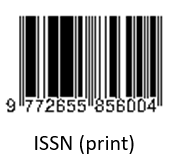Effects of Shock Wave Phenomenon on Different Convergent Lengths in the Mixing Chamber of the Steam Ejector
(1) Sanata Dharma University
(*) Corresponding Author
Abstract
The shock wave phenomenon is a phenomenon in a steam ejector that caused when the working fluid has high pressure, and suddenly it turns into low pressure and high speed. The shock wave effect will be investigated to the different convergent length in the mixing chamber to find the highest entrainment ratio as the performance of steam ejector. Operating pressure in the primary flow was in the range 0.68 MPa - 1.39 MPa, and the secondary flow was set 0.38 MPa to 0.65 MPa. The result of this study demonstrated that the highest entrainment ratio occurred in the convergent length of 69 mm.
Full Text:
PDFReferences
J. Dong, X. Chen, W. Wang, C. Kang, and H. Ma, “An experimental investigation of steam ejector refrigeration system powered by extra low temperature heat source.” Int. Commun. Heat Mass Transf., 2017.
V. V. Chandra and M. R. Ahmed, “Experimental and computational studies on a steam jet refrigeration system with constant area and variable area ejectors.” Energy Convers. Manag., 2014.
N. Ruangtrakoon, S. Aphornratana, and T. Sriveerakul, “Experimental studies of a steam jet refrigeration cycle: Effect of the primary nozzle geometries to system performance.” Exp. Therm. Fluid Sci., 2011.
N. Sharifi and M. Sharifi, “Reducing energy consumption of a steam ejector through experimental optimization of the nozzle geometry.” Energy, 2014.
Y. Zhu and P. Jiang, “Experimental and analytical studies on the shock wave length in convergent and convergent-divergent nozzle ejectors.” Energy Convers. Manag., 2014.
Y. Wu, H. Zhao, C. Zhang, L. Wang, and J. Han, “Optimization analysis of structure parameters of steam ejector based on CFD and orthogonal test.” Energy, 2018.
DOI: https://doi.org/10.24071/ijasst.v3i1.3249
Refbacks
- There are currently no refbacks.
Publisher : Faculty of Science and Technology
Society/Institution : Sanata Dharma University

This work is licensed under a Creative Commons Attribution 4.0 International License.











